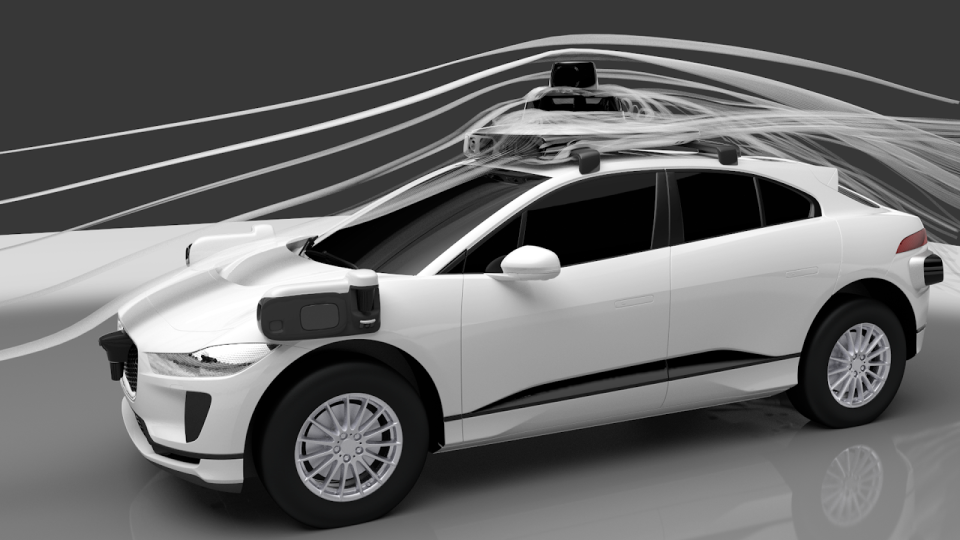It’s essential to understand the aerodynamics of the different vehicle platforms on which Waymo’s autonomous driving technology is applied to build and operate an efficient system – especially when running at full capacity in various conditions such as rain, fog, snow, or extreme temperatures. By using physical tests and state-of-the-art simulation tools, we can optimize energy use, improve sensor performance, and build a safe, stable, scaleable autonomous Driver.
Testing the aerodynamics of the Waymo Driver
The various sensing modalities of the Waymo Driver’s hardware suite – complete with lidar, camera, and radar — are placed at appropriate locations around a vehicle to maximize the autonomous system’s Field of View (FoV). The Waymo Driver’s modular design allows us to easily adapt it to a diverse lineup of vehicle platforms ranging from minivans and SUVs to Class 8 trucks and delivery vans. When integrating our technology with production vehicles, we are mindful of how our sensor suite can alter the complex flow field produced around the vehicle while driving and assess its aerodynamics through a combination of virtual prototyping and physical testing.
Aerodynamic simulations play a key role in many engineering decisions at Waymo, but a few aspects that are somewhat unique to the autonomous industry are highlighted below:
 |
| Through engineering design decisions, the team reduced separated flow around the air beam, overall improving the aerodynamics of the Waymo Via truck. |
Aerodynamic drag – or the opposing force a vehicle needs to overcome to move forward – is mainly influenced by three design factors: frontal-surface area, body shape, and surface finish. This area is often called a vehicle’s A-Surface. Optimizing the A-Surface is a standard process in automotive development; however, because the Waymo Driver’s sensors are designed to maximize the technology’s FoV, it can complicate the process. After we identify the ideal sensor position for the Waymo Driver, we engineer a streamlined sensor mounting structure and housing design, helping to ensure that the air flow stays attached to the vehicle’s exterior surfaces. We also strive to minimize flow separation on mounting structures and sensor housings while balancing complex tradeoffs such as FoV, structural integrity, and Design for Manufacturing. One example of how we manage those tradeoffs can be seen in how we’ve reduced aerodynamic drag on our Waymo Via trucking platform, where we optimized the crossbar sensor housing to minimize the recirculation zone, significantly reducing drag. While this may look like a minor adjustment, it can lead to significant fuel efficiency savings over the lifetime of the vehicle.
Sensor placement
Sensor cleaning
 |
| High-fidelity, multiphase simulations of the Waymo Driver in the rain can help inform whether the team uses an active or passive cleaning mechanism |
A key challenge for drivers of all types is maintaining a clear view of the road. While various environmental factors, including weather, road spray, and organics, can soil one’s field of view, aerodynamics plays a vital role in how fouling particles impinge on vehicle and sensor surfaces. Before the Waymo Driver hits the road, we can study the effect of various road conditions on our sensors through simulations to inform and design the appropriate sensor cleaning mitigation for these conditions. For example, we can deflect small particles such as fog and dust through passive mechanisms. Meanwhile, it’s harder to abruptly change the direction of larger particles due to their inertia. Therefore, larger particles require more active sensor cleaning mitigations, such as wipers and air puffers.
Informing the Waymo Driver’s future vehicle platforms
The above examples are just a glimpse of aerodynamics’ role in shaping the Waymo Driver. As we work on these challenges, we continue refining our simulation methodologies to provide our riders and partners with safer and more efficient options on even more platforms, using flow as our guide.
If you’re interested in joining the rest of the Waymo team and me in delivering the next-generation Autonomous Driver, check out our openings at Waymo.com/careers.


